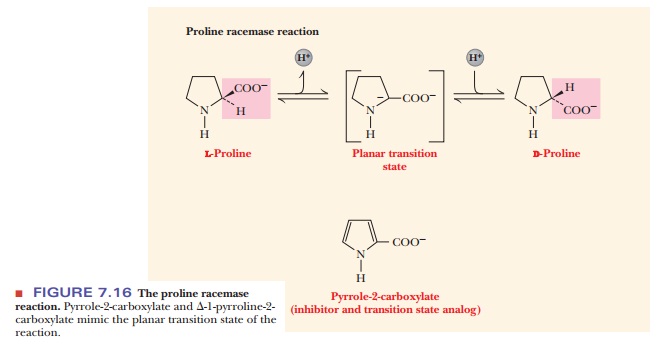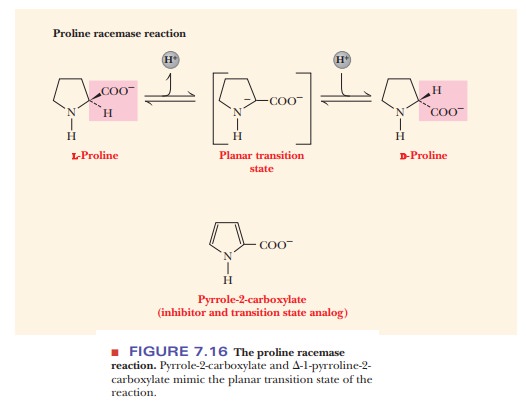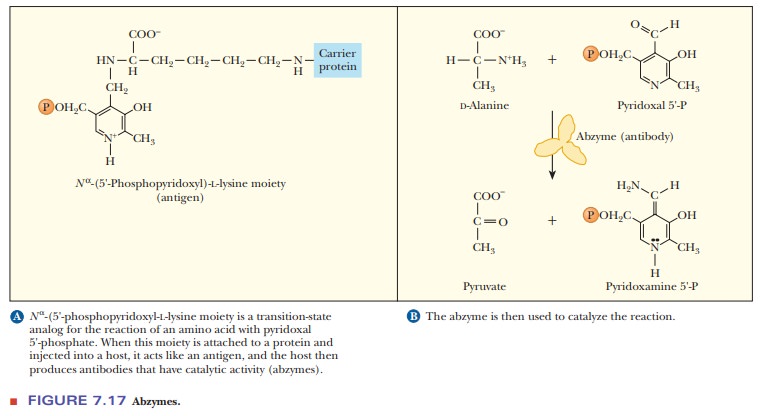Chapter: Biochemistry: The Behavior of Proteins: Enzymes, Mechanisms, and Control
The Active Site and Transition States

The Active Site and Transition
States
Now that
we have spent some time looking at mechanisms and the active site, it is worth
revisiting the nature of enzyme catalysis. Recall that an enzyme lowers the
activation energy by lowering the energy necessary to reach the transition
state (Figure 6.1). The true nature of the transition state is a chemical
species that is intermediate in structure between the substrate and the product.
This transition state often has a very different shape from either the
substrate or the product. In the case of chymotrypsin, the substrate has the
carbonyl group that is attacked by the reactive serine. The carbon of the
carbonyl group has three bonds, and the orientation is planar. After the serine
performs the nucleophilic attack, the carbon has four bonds and a tetrahedral
arrangement. This tetrahedral shape is the transition state of the reaction,
and the active site must make this change more likely.
How do we determine the nature of the transition state?
The fact that the enzyme stabilizes the transition state has been shown many times by the use of transition-state analogs, which are molecules with a shape that mimics the transition state of the substrate. Proline racemase catalyzes a reaction that converts L-proline to D-proline. In the progress of the reaction, the α-carbon must change from a tetrahedral arrangement to a planar form, and then back to tetrahedral, but with the orientation of two bonds reversed (Figure 7.16). An inhibitor of the reaction is pyrrole-2-carboxylate, a chemical that is structurally similar to what proline would look like at its transition state because it is always planar at the equivalent carbon. This inhibitor binds to proline racemase 160 times more strongly than proline does. Transition-state analogs have been used with many enzymes to help verify a suspected mechanism and structure of the transition state as well as to inhibit an enzyme selectively. Back in 1969, William Jencks proposed that an immunogen (a molecule that elicits an antibody response) would elicit antibodies with catalytic activity if the immunogen mimicked the transition state of the reaction. Richard Lerner and Peter Schultz, who created the first catalytic antibodies, verified this hypothesis in 1986. Because an antibody is a protein designed to bind to specific molecules on the immunogen, the antibody is, in essence, a fake active site. For example, the reaction of pyridoxal phosphate and an amino acid to form the corresponding α-keto acid and pyridoxamine phosphate is a very important reaction in amino acid metabolism. The molecule, Na-(5'-phosphopyridoxyl)-L-lysine serves as a transition-state analog for this reaction.

When this antigen molecule was used to elicit
antibodies, these antibodies, or abzymes,
had catalytic activity (Figure 7.17). Thus, in addition to helping to verify
the nature of the transition state or making an inhibitor, transition-state
analogs now offer the possibility of making designer enzymes to catalyze a wide
variety of reactions.

Related Topics